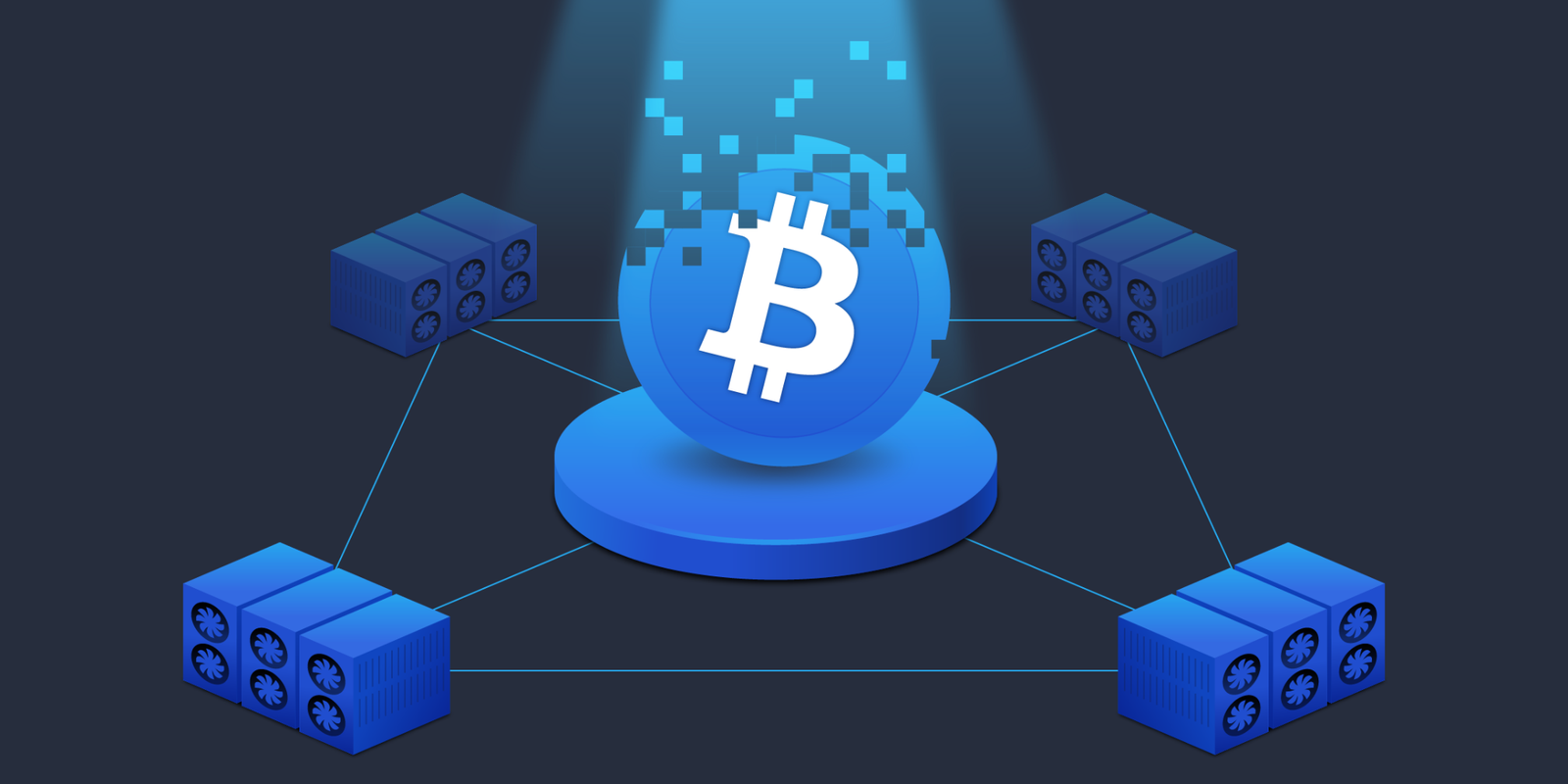Bitcoin blockchain combines the concepts of blockchain and Bitcoin (BTC). The Bitcoin protocol was developed in 2008 by a person or group of persons going by the name Satoshi Nakamoto to decentralize the management of money after centralized institutions failed the world.

A set of computational guidelines described in a document known as the Bitcoin white paper led to the creation of a brand-new class of distributed databases: the blockchain. In January 2009, the network debuted.
Blockchain technology was developed for the cryptocurrency known as Bitcoin, which is also the most popular one. A cryptocurrency, like the US dollar, is a digital medium of exchange that controls the creation of monetary units and verifies financial transfers using encryption techniques.
The term “blockchain” for the data storage system used by Bitcoin describes how the data is organized into “blocks” that are then permanently connected.
A block is a grouping of transactions made in bitcoin over a certain time frame. Blocks are heaped up in stacks on top of one another, with each new block reliant on the previous ones. The word “blockchain” was created as a result of the formation of a chain of blocks.
The prior blocks are rendered unmodifiable each time a new block is inserted. This guarantees that each block becomes more secure over time and is an illustration of how Bitcoin technology is transforming how banking and financial transactions are conducted.
Yet, the Bitcoin blockchain is much more than just a form of money: It is the foundation upon which the majority of cryptocurrencies, including Bitcoin, are created.
Because it guarantees the accuracy of every transaction, the Bitcoin blockchain is exceptional. Nothing is missed from the network since everything that happens on the blockchain is recorded.
The whole record of action is accessible to anyone in the system once it has been time-stamped, recorded, and saved in one of the information blocks.
The Bitcoin blockchain is likewise decentralized, not being kept on a single master computer or managed by a single entity. It is dispersed over numerous computers connected to the network.
Yet the bitcoin blockchain is much more than just money: It is the foundation upon which the majority of cryptocurrencies, like Bitcoin, are created. Because it guarantees that every transaction is accurate, the Bitcoin blockchain is exceptional.
Nothing is missed from the network since every action on the blockchain is recorded. Any user in the system has access to the whole record once an activity has been time-stamped, secured, and logged in one of the information blocks.
The Bitcoin blockchain is also decentralized, which means it is not kept on a single master computer or governed by a single entity. It is spread over numerous machines connected to the network.
On the blockchain network, a block is equivalent to a page in a ledger or record book, a chain refers to blocks connected in a network, and a hash is essentially a fixed-length string formed after transforming any length of input data.
Short story of Bitcoin blockchain
In their work "How to Time-Stamp a Digital Document," Stuart Haber and W. Scott Stornetta first proposed the concept of blockchain technology. They described how to securely record information via a chain of timestamps in this study.
The main reason for creating Bitcoin was to make cryptocurrency exchanges easier. Early adopters and creators quickly realized, however, that it had much more potential.
In light of this, they created the blockchain for Bitcoin to store more information than only information about the token's movement.
Peer-to-peer (P2P) transactions used in bitcoin technology allow it to operate without the need for a bank or other third party to oversee each financial transaction.
Without passing via a banking institution, it enables internet payments to be sent directly from one party to another.
What is needed to make the Bitcoin blockchain work?
Together with a trend to decentralize financial systems, bitcoin stands for a digital, unreliable kind of money. Before Bitcoin, a trusted third party was required to maintain a ledger, which is the method for keeping track of a company's or individual's financial data, to track who owned how much.
No third parties are required because everyone on the Bitcoin network has a copy of this ledger. In the digital environment where bitcoin mining and hash power production take place, known as the bitcoin blockchain network, every transaction involving bitcoin takes place.
Your computer or other hardware's processing power, or "hash power," is what it uses to run and crack various hashing algorithms. These algorithms are used to produce new cryptocurrencies and enable interoperability between them.
Most frequently, Bitcoin owners buy their cryptocurrency through a cryptocurrency exchange, a website that makes it easy to buy and sell Bitcoin and other cryptocurrencies.
The blockchain network is created by the distributed ledger. The latter demonstrates that Bitcoin is a piece of software, a collection of procedures in which users carry out various operations.
A blockchain is a network of computer systems that stores a digital ledger of transactions that have been copied.
Each block of the chain comprises many transactions, and each participant's ledger is updated whenever a new transaction takes place on the blockchain.
Using a technique known as distributed ledger technology, this distributed database is administered by numerous users (DLT). An unchangeable cryptographic signature known as a hash is used to record transactions in the blockchain, a particular type of DLT.
Blocks are then created out of the transactions. For this reason, distributed ledgers are often referred to as "blockchains": each new block includes a hash of the previous one, essentially chaining the blocks together.
The blockchain functions as a ledger, recording each Bitcoin transaction and self-verifying, which means that every action is constantly monitored and secured by the network's nodes, which are various computers that are active participants.
The "miners" enter the picture here: To maintain the chain, their computers put in a lot of work, therefore they get paid in Bitcoin in return.
High-performance computers doing challenging arithmetic tasks to create bitcoins are referred to as miners. To validate every transaction and stop any nefarious actors, the network needs dedicated machines called miners.
A block is put together by bitcoin miners utilizing as many transactions as they can, verified, and added to the chain of blocks before it. The network pays miners in newly created Bitcoin in exchange for their processing power.
How does the Bitcoin blockchain work?
A blockchain is a particular kind of database, which is an electronic collection of data kept on a computer system. Databases, information, and data are typically organized in a table format to facilitate searching for and filtering information.
Large volumes of data may be simply and rapidly accessed, filtered, and modified by many individuals at any time because of the design of databases.
To accomplish this, powerful computers are used to power servers that contain large databases of data. These servers can be created utilizing thousands of PCs.
Why? to possess the processing capacity and power required for numerous users to access the database at once. This is how a database and, say, a disc with cloud-like storage differ.
What sets a blockchain apart from a database is as follows. The first distinction is in the way the data is organized. A database organizes data into tables, but a blockchain gathers data into groups called blocks that contain data sets.
A chain of data is formed when a block is filled, with each block having a defined storage capacity that is chained onto the block that was filled earlier. Because of the chaining together of millions of data-filled blocks, it is known as the blockchain.
According to this concept, each blockchain operates as a more complex database because, when used in a decentralized system, they produce an irreversible chain line of data.
Each block in the chain has an associated timeline after a block is filled, making it impossible to change. The blockchain aims to enable the recording and distribution of digital information without its editing.
As a result, it is not a database per se because it cannot be altered once it has been filled and chained. Blockchain technology had its first practical use with the introduction of Bitcoin technology.
The limitations of the Bitcoin blockchain
Even while the blockchain has numerous advantages, everything has disadvantages. The first is that when there are too many users on the network, the blockchain may sluggishly.
Due to its consensus working approach, scaling is also more difficult. Another drawback is that the blockchain's data is immutable; once a block has been written, it cannot be changed.
Some may consider it to be an imitation that demands users maintain their wallets in order to maintain access.
The fact that blockchain technology is still in its infancy is a significant constraint. Also, it is challenging to incorporate into legacy systems and doesn't allow interoperability with other blockchains or other financial systems.
